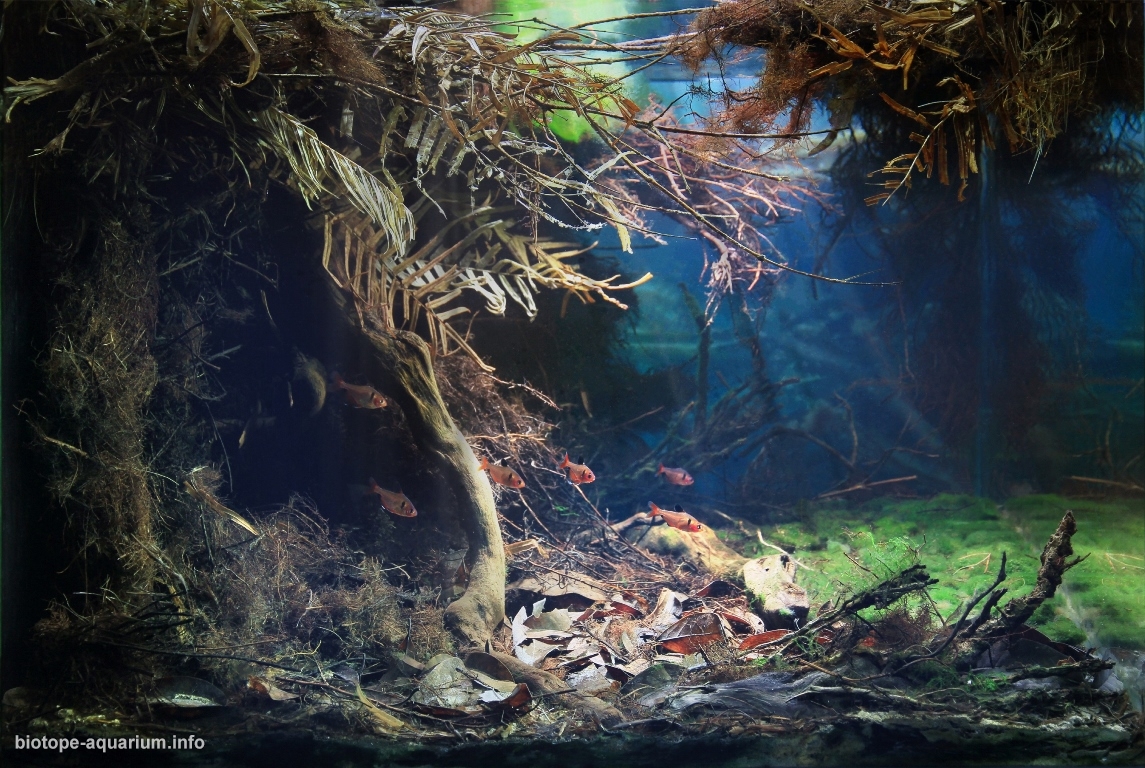Rio Olho d’água, the tributary of Rio da Prata, Mato Grosso do Sul, Brazil
_th place in Biotope Aquarium Design Contest 2020

Volume: 216 L
Dimensions: 60x60x60 cm
List of fishes: Hyphessobrycon eques
List of plants: There are no plants except for some algae in the place I described.
Description of decorations: When I accidentally saw a photo of Rio Olho d’água taken by Tai Strietman on Facebook, I was deeply touched by the underwater landscape. An idea came up, I want to make a biotope aquarium to restore the habitat to give my fish a perfect home.
All the elements used in my aquarium, including branches and fallen leaves, were derived from natural collection. I chose white fine sand as the substrates and put some limestones inside which are consistent with the habitat to maintain the similar water quality. I used big branches to build the skeleton and placed some small branches and leaves on the top. Sunlight shines into the aquarium from the gap between the upper layer branches and leaves and onto the algae on the ground. There are a lot of shelters in the aquarium for fish to hide and enough open space for fish to play. As time goes by, the leaves and roots will slowly rot and disappear after a few months, which is a microcosm of the ecological cycle of nature.
Description of equipment: Kessil Tuna Sun 360x 90w LED, Spectrum 6,000K to 9,000K, EHEIM 600 classic external filter (1000 L/H)
Water parameters: Aquarium water looks clear. The aquarium is kept at room temperature at about 24-26°C at this time of year. pH is 7.4
Additional info: Change 1/5 water once a week
INFORMATION ABOUT BIOTOPE:
Description of the area surrounding the biotope: Rio Olho d’água is the tributary of Rio da Prata, which is located in Mato Grosso do Sul, on the border with Bonito. The region is one of the most important eco-tourism areas in Brazil with its crystal-clear waters and beautiful natural landscapes such as waterfalls, caves and forests. The Rio da Prata River is the third cleanest river in the world. In addition to hiking through the rainforest and watching 234 species of birds, snorkeling in the lower reaches of the river and enjoy watching as many as 56 species of fish is also a good choice.
Description of the underwater landscape of the biotope: The substrate of the river is fine white sand. There are a lot of limestone on the surface of the riverbed. Since the river water is naturally filtered by limestone, and impurities are deposited in the riverbed, the water is very clear and transparent.
There are plenty of Heteranthera zosterifolia distributed in particular areas of the river, which give the inhabited fish spaces to escape and reproduce, and also provide sufficient food resources. However, there are no plants in most areas of the river. Roots, branches and leaves fall to the river and gather in the slow-flowing area, which provide shelter and additional food source for inhabited fishes. Roots, branches and leaves fall to the river and gather in the slow-flowing area, which provide shelter and additional food source for inhabited fishes.
Description of the parameters of the habitat: The highest temperature of Mato Grosso do Sul happens in December, February and March. The average temperature is about 26.8 °C in December. The water at the source of the Olho D’Água River has a constant temperature of 24° C throughout the year. The temperature is ideal: refreshing in the summer and warm in the winter even the temperature outside is low. Mato Grosso do Sul has some slightly muggy months and moderately humid months on the other months of the year. The least humid month is September (45.7% relative humidity), and the most humid month is May (65%). The riverbed contains a lot of limestone and the pH is around 7.4 in dry season. During the rainy season, rising rivers will flood some of the plants and soil on the shore, pH will go lower.
List of fishes and invertebrates occurring in the nature biotope: Hyphessobrycon eques, Moenkhausia sanctofilominae, Phenacogaster tegatus
List of plants found in the nature biotope: There are plenty of Heteranthera zosterifolia distributed in particular areas of the river, which give the inhabited fish spaces to escape and reproduce, and also provide sufficient food resources. However, there are no plants in most areas of the river.
Threats to the ecology: With the continuous expansion of human activities, a large number of rainforests have been felled, and the habitat of living things has been severely damaged, seriously affecting the ecological balance of the earth. Rio da Prata’s (including Rio Olho d’água) excellent management of tourism activities has become the flag of Brazil. Not only the number of tourists is restricted, but also the application of sunscreen and mosquito repellent water before launching, which provides an effective guarantee for the ecological stability and species diversity of the Rio da Prata River.
Sources of information:
- Video of Recanto Ecologico Rio da Prata, Tai Strietman
- Rio Olho d’água || the tributary of Rio da Prata river
- General information about Olho d’água – https://www.riodaprata.eco.br
- Weather of Mato Grosso do Sul – https://championtraveler.com/dates/best-time-to-visit-bonito-mato-grosso-do-sul-br/
